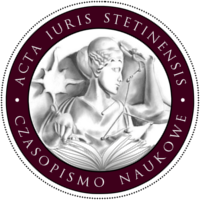






| Authors: |
Irmina Weronika
Stodulska

Akademia Sztuki Wojennej |
| Keywords: | Isidore of Seville magic magicians magical professions Roman law |
| Whole issue publication date: | 2024-09 |
| Page range: | 16 (95-110) |
| Downloads ?: | 139 |
| 1. | Dębiński A., Problematyka prawna w «Divinae Institutiones Laktancjusza», “Roczniki Nauk Prawnych” 1997, No. 7, pp. 139–151. |
| 2. | Dębiński A., Wiedza o prawie w ujęciu Izydora z Sewilli, “Studia Prawnicze KUL” 2022, No. 1, pp. 125–141. |
| 3. | Dębiński A., Jońca M., Słowo wprowadzenia, in: A. Dębiński, M. Jońca (eds.), Izydor z Sewilli. O prawach, Lublin 2021. |
| 4. | Díaz y Díaz M.C., Introducción general, in: J. Oroz Reta, M.-A. Marcos Casquero (eds.), San Isidoro de Sevilla, Etimologías. Edición bilingüe, texto latino, versión española y notas, Madrid 2004, pp. 1–258. |
| 5. | Drączkowski F., pp.v. Izydor z Sewilli, in: Encyklopedia Katolicka, Vol. VII, Lublin 1997. |
| 6. | Fontaine J., Cohérence et originalité de l’étymologie isidorienne, in: F. Rodríguez, J. Iturriaga, (eds.), Homenaje a Eleuterio Elorduy S.J., Bilbao 1978, pp. 142–144. |
| 7. | Fontaine J., Isidore de Seville et la culture classique dans l’Espagne wisigothique, Paris 1959. |
| 8. | Fontaine J., Isidore de Séville. Genèse et originalité de la culture hispanique au temps de Wisigoths, Turnhout 2001. |
| 9. | Fontaine J., Cazier P., Qui a chasse de Carthaginoise Severianus et les siens? Observations sur l’histoire familiale d’Isidore de Séville, w: Estudios en homenaje a Don Claudio Sánchez Albornoz en sus 90 años, Vol. 1, M. del Carmen Carlé (ed.), Buenos Aires |
| 10. | 1983, pp. 349–400 (reprint in: J. Fontaine, Tradition et l’actualité chez Isidore de Séville, London 1988). |
| 11. | Garcia Gallo A., San Isidoro jurista, in: M.C. Díaz y Díaz (ed.), Isidoriana, Estudios sobre San Isidoro de Sevilla en el XIV Centenario de su nacimiento, León 1961, pp. 133–141. |
| 12. | Hernando Cuadrado L.A., La gramática en las «Etymologiae» de San Isidoro, “Miscelánea Comillas. Revista de Ciencias Humanas y Sociales” 2013, Vol. 71, 139, pp. 327–349. |
| 13. | Introduction, in: S.A. Barney, W.J. Lewis, J.A. Beach, O. Berghof (eds. and transl.), The Etymologies of Isidore of Seville, Cambridge 2006. |
| 14. | Jońca M., Przestępstwo znieważenia grobu w rzymskim prawie karnym, Lublin 2013. |
| 15. | Klingshirn W.E., Inventing the sortilegus: Lot Divination and Cultural Identity in Italy, Rome, and the Provinces, in: C.E. Schultz, Paul B. Harvey Jr. (eds.), Religion in Republican Italy, “Yale Classical Studies” Cambridge, 2006, No. 3, pp. 137–161. |
| 16. | Klingshirn W.E., Isidore of Seville’s Taxonomy of Magicians and Diviners, “Traditio” 2003, No. 58, pp. 59–90. |
| 17. | Криницына Е.С., Исидор Севильский как правовед: от римского права к латинскому богословию, “Вестник РГГУ. Серия История. Филология. Культурология. Востоковедение” 2011, Vol. 14, pp. 208–228 (Krinicyna E.S., Isidor Sewilskij kak prawowied: ot rimskogo k łatinskomu bogosłowiju, “Wiestnik RGGU. Serija Istorija. Fiłołogija. Kulturologija Wostokowiedienije” 2011, Vol. 14, pp. 208–228). |
| 18. | Krynicka T., Izydor z Sewilli, Kraków 2007. |
| 19. | Ledzińska A., Gramatyka wobec sztuk wyzwolonych w pismach Izydora z Sewilli. Origo et fundamentum liberalium litterarum, Kraków 2014. |
| 20. | Riché P., Education and Culture in the Barbarian West: Sixth through Eighth Centuries. Columbia 1976, trans. by J.J. Contreni from Education et culture dans l’Occident barbare, 6e–8e siècle, Paris 1962. |
| 21. | Марей А.В., Колдовство в законодательстве Поздней Империи, „Вестник древней истории” 2012, № 2, pp. 166–175 (Mariej A.W., Kołdowstwo w zakonodatielstwie Pozdniej Impierii, “Wiestnik driewniej istorii” 2012, No. 2, pp. 166–175). |
| 22. | Salij J. (ed.), Św. Tomasz z Akwinu, Ewangelia Ojców Kościoła, Poznań 2001. |
| 23. | Schmidt R., “Origines” oder “Etymologiae”? Die Bezeichnung der Enzyklopädie des Isidor von Sevilla in den Handschriften des Mittelalters, in: A. Hofmeister, U. Scheil (eds.), |
| 24. | Festschrift für Adolf Hofmeister zum 70. Geburtstage am 9. August 1953 dargebracht von seinen Schülern, Freunden und Fachgenossen, Halle 1955, pp. 223–232. |
| 25. | Smoliński P., Izydor z Sewilli, in: A. Maryniarczyk et al. (eds.), Powszechna encyklopedia filozofii, Vol. 5, Lublin 2002. |
| 26. | Starowieyski M., Obraz literatury klasycznej pogańskiej w dziełach Izydora z Sewilli. Part II. Literatura rzymska, “Meander” 1975, No. 30, pp. 19–35. |
| 27. | Уколова В.И., Античное наследие и культура раннего Средневековья (конец V – середина VII века), Москва 1989 (Ukołowa W.I., Anticznoje nasledie i kultura ranniego Sriedniewiekowia (koniec V – sieriedina VII wieka), Moscow 1989). |
| 28. | Wygralak P., Stanowisko Kościoła wobec idolatrii i magii na terenach Galii i Hiszpanii w późnej starożytności chrześcijańskiej (VI–VII w.), Poznań 2011. |
| 29. | Wypustek A., Magia antyczna, Wrocław 2001. |